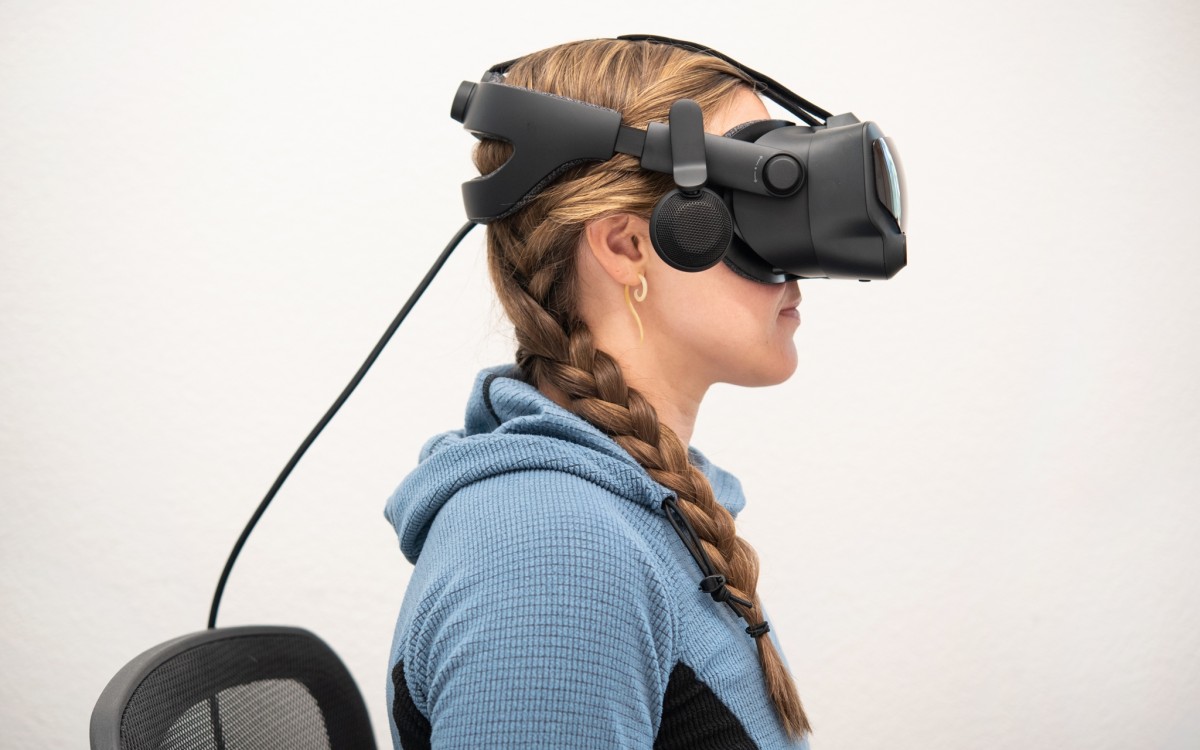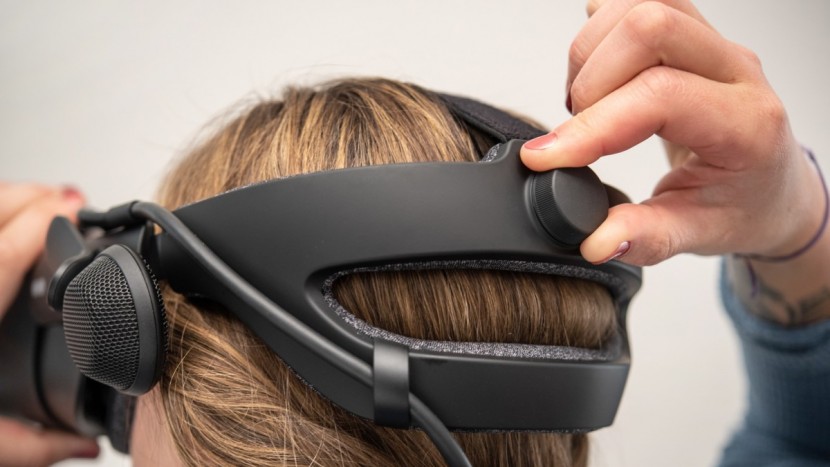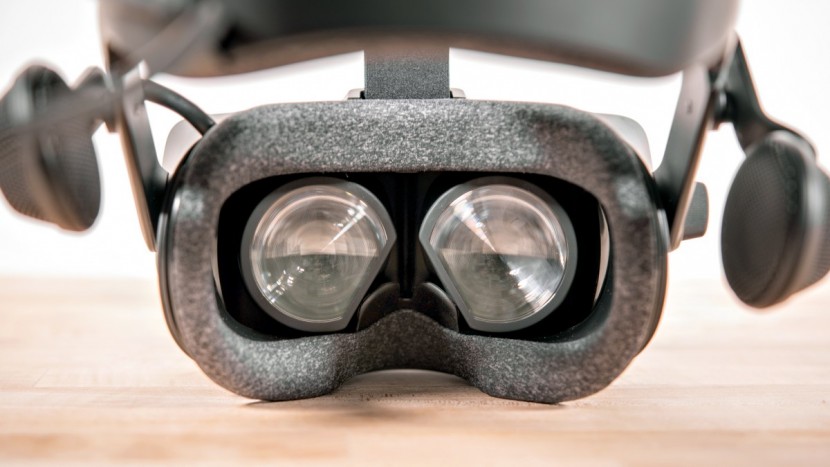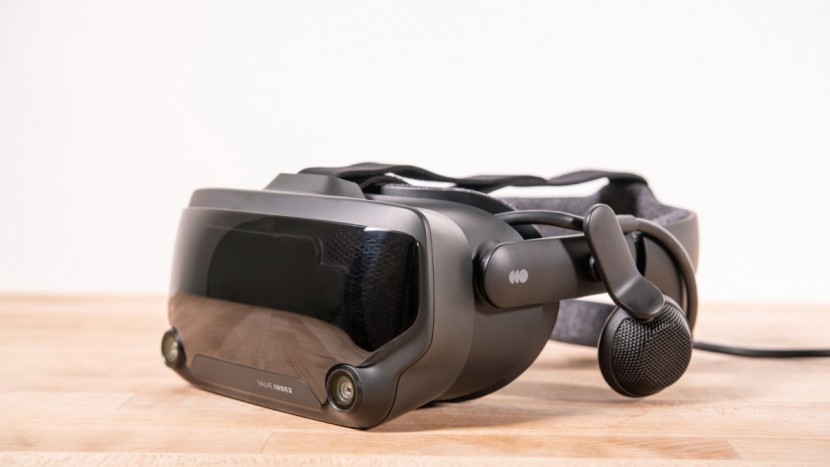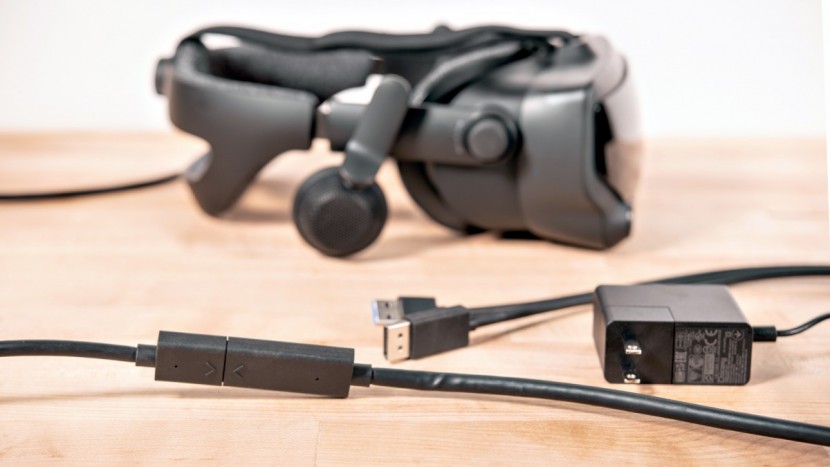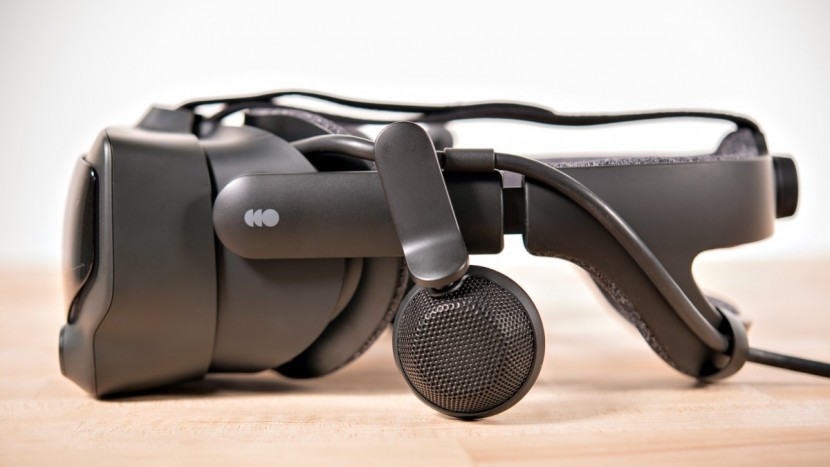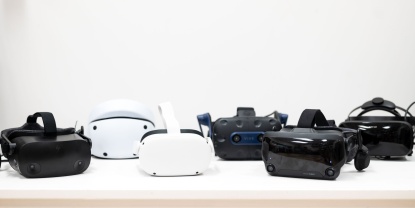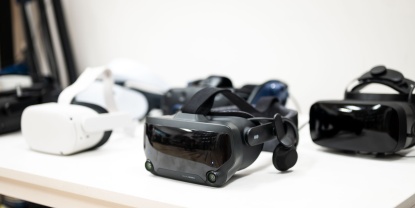Our Verdict
Compare to Similar Products
 This Product Valve Index | |||||
|---|---|---|---|---|---|
| Awards | Runner Up Headset | Best Overall/Stand Alone | Working and Relaxing | ||
| Price | $999 List | $550 List $499.00 at Amazon | $500 List $499.99 at Amazon | $3,699 List | $799 List $699.00 at Amazon |
Overall Score  |
|||||
| Star Rating | |||||
| Bottom Line | A solid and high-performing VR headset that doesn't require a top-shelf GPU | This great value headset should excite PS5 players looking for upgraded VR immersion | One of the best standalone headsets on the VR market represents evolutionary improvements on the Quest 2 at a reasonable price | A sharp innovative (and expensive) display geared more toward browsing, work, and movie watching than gaming | This headset will appeal to users with glasses or who require top-notch tracking precision |
| Rating Categories | Valve Index | PlayStation VR2 | Meta Quest 3 | Apple Vision Pro | Vive Pro 2 Headset |
| Tracking (35%) | |||||
| Comfort (30%) | |||||
| Visuals (15%) | |||||
| User Friendliness (15%) | |||||
| Ease of Setup (5%) | |||||
| Specifications | Valve Index | PlayStation VR2 | Meta Quest 3 | Apple Vision Pro | Vive Pro 2 Headset |
| Measured Weight | 1.86 lbs | 1.31 lbs | 1.13 lbs | 1.37 lbs | 1.94 lbs |
| Tracking type | External Sensors | Built-in Cameras | Built-in Cameras | Built-in Cameras | External Sensors |
| Per Eye Manufacturer Resolution | 1440 x 1600 | 2000 x 2040 | 2064 x 2208 | 3660 x 3200 | 2448 x 2448 |
| IPD Adjustment | Mechanical IPD: 58 - 70mm | Mechanical IPD: 57 - 73mm *Rough measurement |
Mechanical IPD: 53 - 75mm | Automatic IPD: 51 - 75mm | Mechanical IPD: 57 - 70mm |
| Measured Horizontal Field of View | 110º | N/A | 100º | 95º | 110º |
| Measured Vertical Field of View (Up) | 40º | N/A | 35º | 25º | 32º |
| Measured Vertical Field of View (Down) | 45º | N/A | 45º | 35º | 32º |
| Manufacturer Field of View | Optimized eye relief adjustment allows a typical user experience 20º more than the HTC Vive | 110º | 110º | N/A | Up to 120º |
| Manufacturer Refresh Rate | 80, 90, 120, 144 Hz | 90, 120 Hz | 72, 80, 90, 120Hz | 90, 96, 100Hz | 90, 120 Hz (only 90Hz supported via VIVE Wireless Adapter) |
| Sound | Built-in, 37.5mm off-ear | 3.5 mm port, included earbuds Bluetooth connected via the Console |
Built-in headband 3.5 mm audio port optional |
Built-in headband | Built-in, on or off-ear |
| Connection Type to PC | - DisplayPort 1.2
|
- USB-C | Stand alone (Optional PC Connection: Meta Quest Link Cable and Air Link ) |
Wifi with a 3rd party workaround | - DIsplayPort (DP to mini-DP adapter included)
|
| Room For Glasses | Below average | Excellent | Average | No | Above Average |
| Manufacturer Minimum PC Specs | OS: Windows 10 Processor: Dual Core with Hyper-Threading Memory: 8 GB RAM Network: Broadband Internet connection Additional Notes: Available DisplayPort (Version 1.2) and USB (2.0+) Port Required |
N/A Uses PS5 | Optional Link Cable Setup OS: Windows 10 / Windows 11 Processor: Intel i5-4590 / AMD Ryzen 5 1500X or greater Memory: 8GB+ RAM USB Port: 1 USB Port |
N/A | OS: Windows 11 / Windows 10 Processor: Intel Core i5-4590 or AMD Ryzen 1500 equivalent or greater Memory: 8 GB RAM or more Video Out: DisplayPort 1.2 or higher. DisplayPort 1.4 or higher with DSC is required for Full Resolution mode. |
| Manufacturer Minimum GPU | NVIDIA GeForce GTX 970, AMD RX480 | N/A Uses PS5 | Optional Link Cable Setup Supported GPUs: NVIDIA Titan X, NVIDIA GeForce GTX 970, NVIDIA GeForce GTX 1060 Desktop 6GB, NVIDIA GeForce GTX 1070(all), NVIDIA GeForce GTX 1080(all), NVIDIA GeForce GTX 1650 Super, NVIDIA GeForce GTX 1660, NVIDIA GeForce GTX 1660 TI, NVIDIA GeForce RTX 20-series (all), NVIDIA GeForce RTX 30-series Please Note: NVIDIA 3050 (laptop) and 3050ti GPUs are not recommended for use with Link. AMD 400 Series, AMD 500 Series, AMD 5000 Series, AMD 6000 Series, AMD Vega Series Please note: the Radeon RX 6500 is not recommended for use with Link. |
N/A | NVIDIA GeForce GTX 1060 or AMD Radeon RX 480 equivalent or greater. (Not full resolution) |
| Manufacturer Recommended PC Specs | Processor: Quad Core + Additional Notes: Available USB (3.0+) Port Required for Headset Pass-Through Camera & USB Port Support |
N/A Uses PS5 | Optional Link Cable Setup OS: Windows 10 / Windows 11 Processor: Intel i5-4590 / AMD Ryzen 5 1500X or greater Memory: 8GB+ RAM USB Port: 1 USB Port |
N/A | Better than Minimum Specs |
| Manufacturer Recommended GPU | NVIDIA GeForce GTX 1070 or better | N/A Uses PS5 | Optional Link Cable Setup Nvidia RTX 20 Series, AMD Radeon RX 6000 Series, or greater |
N/A | GeForce RTX 20 Series (Turing) or AMD Radeon 5000 (Navi) generations or newer required for Full Resolution mode. |
| Hardware Platform Needed | PC | PS5 (PlayStation 5) | Stand alone (optional tether to VR ready PC) |
Stand alone | PC |
Our Analysis and Test Results
The Valve Index's is one of our old favorite headsets. Through the years, its excellent design and solid performance have kept this model relevant. What was once a premium VR option reserved for absolute enthusiasts still holds the line today as a great value, thanks to its superior tracking, large field of view, impressive refresh rate, and comparatively low PC power demands.
Tracking
Our tracking metric measures the responsiveness and accuracy of headsets and motion controllers in VR games and experiences. VR kits paired with external sensor units tend to outperform those with headset-integrated sensors, and that's certainly the case here. The Valve Index, with its two external sensors, took top honors in tracking, demonstrating exceptional accuracy and consistency in our go-to test games, Beat Saber and Half-Life Alyx.
Tracking in Beat Saber was flawless in both standard and 360-degree songs. Wild hand flailing, controller behind-the-back shenanigans; nothing we did could trip up the Index's tracking in this game, so we'd highly recommend it if you want to be competitive in rhythm-based VR titles. The same goes for Half-Life Alyx. Tracking performance was excellent, ensuring total and reliable accuracy as we ducked and blasted our way past our alien overlords.
Comfort
In these tests, we weigh in on the material and design aspects that contribute to or detract from the headset's overall comfort level when in use. We found the comfort level of the Valve Index to be pretty average among headsets we've tested.
It weighs in at a solid 1 pound 13.5 ounces with the tether cable running down the left side. The Index is well-balanced, with a slight front heft if you're paying attention to it. The face mask is nice and comfortable, and we only had issues with the visor moving around our faces if we shook the headset vigorously.
Heat and sweatiness during activity add up to another average score for the Index. It's not substantially hotter than other headsets, but the visor itself does heat up and seems to radiate heat through the nose area rather than to the forehead. Where the Index really falls short in comfort, though, is its abysmal accommodation for eyeglasses. We were able to squeeze our specs into the visor, but the fit was so tight, with so many hotspots and so much nose bridge pressure, that we wouldn't recommend this one to anyone who plans to use it with glasses.
Visuals
In our visuals tests we explore the headset's clarity and field of view (FOV), which can make or break VR immersion. The Valve Index falls short here, with a screen resolution of 1440 x 1600 pixels per eye. That's lower than most current-generation VR headsets, but resolution isn't the whole show, so we put the Index through its paces in our trusty visual test apps: Beat Saber, Half-Life Alyx, and Realovirtual Workshop.
Valve lists the Index's FOV at 110 degrees, and we matched that in our horizontal Realovirtual Workshop test. Vertical FOV came in around 45 degrees for us, but keep in mind that face shape and eye socket depth can play a huge part in how far a person can see peripherally in a VR headset. In practice, the Index had the best FOV of all headsets tested, redeeming it for its lower resolution, and we also appreciate its linear (57mm-73mm) mechanical interpupillary distance (IPD) slider to dial in perfect eye alignment with the lenses.
The Index's middling resolution comes into play in our testing with Beat Saber and Half-Life Alyx. We experienced a noticeable screen door effect (SDE) in both. SDE occurs when the human eye can see pixels and the spaces between them when extremely close to a video screen. It looks a lot like peering through a mesh screen, and it's present in most current VR headsets to varying degrees. SDE can diminish VR immersion initially, but it tends to fade from the mind as things get going and your focus shifts to the in-game action. A wide FOV balances the SDE out for adequate immersion in the case of the Valve Index. Another thing going for the Index is how reliably smooth it runs, offering refresh rates of 80, 90, 120, and up to a class-leading 144hz if you have GPU power.
User Friendliness
Our daily use metric rates VR headsets on the user experience of putting them on, entering VR, and the convenience of fine-tuning the fit. Here again, the Valve Index reigns supreme with the best-in-class head strap system and other nice touches.
Initial headset fitting is among the easiest of all the units we tested. Just hold the facemask up to your face and look in, pull the top strap snug to secure the vertical position, then turn the knob on the back of the strap to dial in the tension around your head. After that, taking the headset on and off is effortless thanks to a spring-like elasticity that lets you temporarily expand the fit by pulling the visor and back pad apart. You should only have to repeat those initial steps if you share with other players, and if you do, fit setup is just as easy every time.
The over-ear headphones on the Index can be rotated 90° out of the way when not in use, and didn't impede taking the headset on or off even when they were in the down position. They sound good, although airier than earbuds, with no sound isolation. The built-in dual microphone array was also nice — crisp and clear sounding.
Ease of Setup
We put on each headset and played a myriad of games to examine our experience with each headset's initial setup process and additional hardware and PC requirements. VR kits requiring us to set up external sensor units score lower in this metric, and that goes for the Valve Index.
The setup starts with a fresh SteamVR installation and a Steam account sign-up or log-in. Next, you'll prepare your play area, ensuring it's hazard-free, then go through the motions of setting up at least two sensor units (Base Stations), motion controllers, and the headset.
VR boundary setup is pretty straightforward for the Index. With the Index, instead of having to carry a cable around with you during use, it simply requires you to stand in the center of your play area, aim the controller at your computer monitor, and pull the trigger. Then, you carve out the area that you'll be using with one controller. Finally, the user will place both controllers on the floor to register the floor level, and you're ready to play.
The minimum PC requirements for the Index are a dual-core processor with hyper-threading, 8GB RAM, and a Geforce GTX 970 or better graphics card. The Index can run on Windows 10 and 11, SteamOS, and Linux.
Should You Buy the Valve Index?
If you value excellent motion-tracking and reliable performance and don't mind sacrificing a bit of screen resolution, the Valve Index will serve you well. It's the cheapest external sensor setup by a long shot and a great value. However, if you'd prefer better visuals or a less complicated wireless sensor setup, you'll have plenty of options at both ends of the price/performance spectrum.
What Other VR Headset Should You Consider?
If you want the best visuals available, don't want to mess with external sensors, and don't need the most responsive tracking, check out the excellent Apple Vision Pro. If you require cutting-edge visual immersion and flawless tracking, check out the premium but spendy Valve Index, which uses external sensors to provide a top-notch and fast-paced gaming experience. See our top-ranked vr headsets to find your perfect fit.


